Jesper Tønnes: The Formats are also part
of the Storytelling |
Read more at in70mm.com The 70mm Newsletter |
| Written, interviewed and photographed by: Thomas Hauerslev | Date: 08.08.2024 |
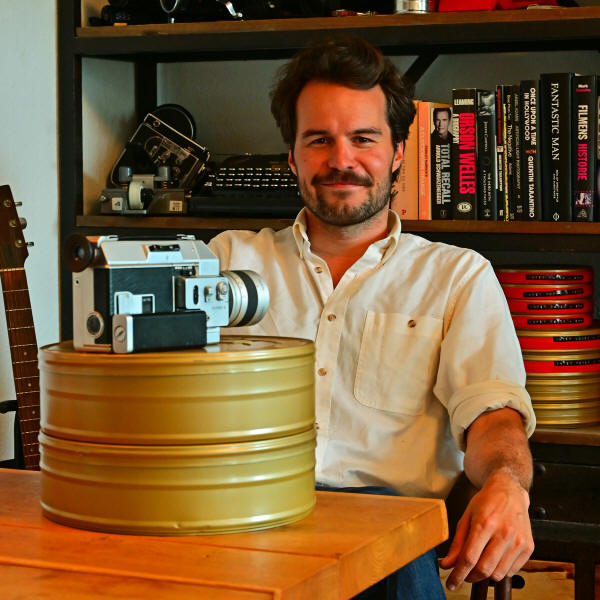 Jesper Tønnes
(b. 1990) is a director, writer and actor who was born
in Føvling, Denmark. He grew up in the countryside with a great passion for
storytelling and film. He currently lives
in Copenhagen. Jesper Tønnes
(b. 1990) is a director, writer and actor who was born
in Føvling, Denmark. He grew up in the countryside with a great passion for
storytelling and film. He currently lives
in Copenhagen.Thomas Hauerslev: Jesper, tell me a little bit about yourself and your interest in movies, and how you got started in the industry? Jesper Tønnes: I've been working in film and theatre in Copenhagen since 2011 when I was 21 years old. I always knew I wanted to work with film, and performances and with music. They were kind of my first loves. I had a very strong relationship with TV when I was a kid, watching late night movies with my parents and grandparents. It was a big part of growing up, being together as a family, watching movies. It just really resonated with me. I always loved storytelling. When and whenever I played outside, it would always be with me and friends coming up with a story, and then exploring that universe together. So in some kind of strange way you could say that I've just kept doing that for my entire life. I started out wanting to be an actor. But fairly early on I realized that my strength was not as an actor but instead as an initiator, a person who can bring people together and create something. At 24, I kind of said "I'm not going to pursue acting as intensely. I'm going to start pursuing directing and I'm going to start doing short films". I did a bunch of short films and a bunch of plays, writing and directing. Doing that kind of work, my own productions, I suddenly ended up as a being cast as a model in a commercial where we had to go to Montenegro to shoot some scenes. The photographer, who I didn't know before, was Manuel Alberto Claro, who shot all Lars von Trier's latest films, like “Melancholia”. A very renowned Danish cinematographer. We met and had a really good time in Montenegro. When we came home, we met for a cup of coffee, and I came to realize who he was and what he had done. I said to him I wanted to find a way into the more professional Danish film business. He said he had a short film coming up, and “you could come along, be first assistant director on that”. And then I did just that in the northern part of Jutland, and we shot a very nice movie. The people who produced that were an advertising agency. After I came home, I soon had a job on an IKEA commercial, as a first assistant director and from there on, in 2018 when I turned 28 I started working full time. I went from being a substitute teacher doing small art projects whenever I had the time and the money, to become a full-time first assistant director. I did commercials and some Christmas TV series, which are very big in Denmark. I did one film and then another big TV show. I had a wild couple of years where I worked with Lars von Trier, Thomas Vinterberg and Nicolas Winding Refn, which was kind of crazy. That's my main job these days as a first assistant director, and then when I have time off, I direct my own stuff. What I really want to do is to direct and that is what I feel is my passion. • Go to gallery Cast / Crew screening "Nothing Ventured" & "CUT" • Go to "CUT" with ARRI 765. A Unique Analogue Workshop Event • Go to "Nothing Ventured" in ARRI 765 It's very nice to live in a world where you create art. That's my biggest advice for anybody who wants to do what I do. Don't be a waiter and then direct films on the side. There's too much interval between your two jobs. Find something that's actually pretty close to what you want to do, and then do that. Being a first assistant director for me was perfect because when I want to do films, the people I like, my friends and my colleagues are very competent film makers. I know people personally who I can call up, who like me and I like them, and then we help each other out making very nice stuff. That's also how I did my two latest films ["Nothing Ventured" & "CUT", ed]. Especially these latest ones which are shot on film. These were only possible because I know so many really talented and professional film workers. They are employed in the movie business, but who they're also willing to spend some free time making some of my silly film projects. |
More in 70mm reading: "CUT" with ARRI 765. A Unique Analogue Workshop Event Gallery The Making of "CUT" Cast / Crew screening "Nothing Ventured" & "CUT" "Nothing Ventured" in ARRI 765 in70mm.com News Peripheral Vision, Scopes, Dimensions and Panoramas in70mm.com's Library Presented on the big screen in 7OMM 7OMM and Cinema Across the World Now showing in 70mm in a theatre near you! 70mm Retro - Festivals and Screenings |
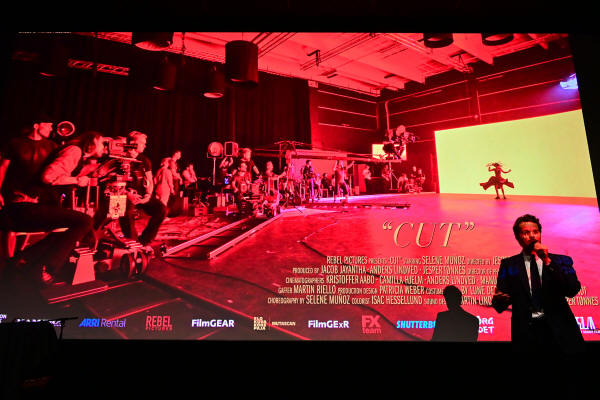 Jesper
Tønnes introducing “CUT”, which premiered Saturday 29. June 2024 at
the Empire cinema, screen 1 in Copenhagen for friends, family, cast and
crew. Jesper
Tønnes introducing “CUT”, which premiered Saturday 29. June 2024 at
the Empire cinema, screen 1 in Copenhagen for friends, family, cast and
crew.THa: I saw your new film “CUT”, which you premiered last week at the Empire cinema [in Copenhagen, ed] for friends, family, cast and crew. Magnificent short film. Loved it. Fantastic! Especially because I witnessed it being photographed on a Friday afternoon in August last year. Tell me about it, and why you chose to shoot “CUT” in four different film formats, Super 8 to 65mm. Jesper: Yes, I did two films simultaneously. I did “CUT”, which is a 5 minute short flamenco dance film, and then I did a 30 minute short film called “Nothing Ventured”. Both films have this in common: they're shot on all four Kodak film formats. While working on “Nothing Ventured”, I was talking to my Director of Photography, Anders Lindved, and we realized that we were going to have all four formats and cameras in Copenhagen at the same time for 48 hours. “Nothing Ventured” is a story, a piece of fiction, and all the cameras are being used at different times. But I was thinking, why not shoot the same thing in all four formats, to study the difference more closely? The idea from the beginning was that these formats, just like lenses and colours and the way formats work, and the way analogue resolution affects the image, these are all also a piece of the storytelling. It affects how we view the story being filmed, and I wanted to create a film that explored that, by literally telling a story, and when the story changes, the format changes. I wanted to explore how changing the format affects the film. How is the story and how is the setting affecting the film? I was a bit sad that we never really did an actual side-by-side comparison where we took all four cameras and filmed the same thing at the same time. Then we could sit down as nerds, and say, “Ohh, that's the difference! That is the literal difference right there! Because now I can see it very clearly”. Anyway, one day I wrote Kodak and ARRI Rental and I said:
And Kodak was like a [BIG smile]…,
because I now realise it's a very good test for them to have as well.
But they said “Yes, we would love to sponsor film for that - even
65mm”, which in Danish money is around DKK 2000 a minute [currently
about USD $290 - ed.]. And that price is at a discounted rate if you should have buy it. It's so expensive to shoot 65mm.
They said yes, they wanted to sponsor it! Then I started to exploring
the idea of what it could be, this thing that we could shoot at the
same time. I knew of this wonderful flamenco dancer by the name of Selene Muñoz, who lives in Copenhagen. I really wanted to do something
where we could explore a bit of movement and a bit of texture. I wanted
to mix as well as … maybe it should be Selene dancing? Because that's
music, and that's very interesting to just to look at and listen to.
What's also fantastic about Flamenco is that it's very rhythmic. It
would be an opportunity to create something where the cuts between the
formats would be motivated by Selene's rhythm. It could even be a story
about her rhythm, where you could have moments where she dictates the
cuts by snapping her fingers or clapping. That was the very quick
general idea of what that film was going to be. |
|
 Camilla Hjelm
Knudsen with the ARRI Super 16 camera. Winner of European Cinematographer
2016 - Prix Carlo di Palma for LAND OF MINE Camilla Hjelm
Knudsen with the ARRI Super 16 camera. Winner of European Cinematographer
2016 - Prix Carlo di Palma for LAND OF MINEThen I brought on Kristoffer Aabo as a Director of Photography, to help me finalize the vision, create a shooting plan and a shooting schedule of how we're going to do it. I always had a very strong idea of how I wanted Selene to move and the story I wanted to tell. But when we brought Selene into that mix with me, Kristoffer, Anders Lindved and Jacob Jayantha, who helped me produce the film, we started bringing everything together. It wasn't that hard because Selene has so much material. She's been a professional dancer and a choreographer her whole life. She is so good, and when you have people who are so talented and so good at what they do, it's very hard to do a bad job filming someone like that. It's a very good place to start, when the foundation is excellent [smiling]. And that's how it was working with Selene. We came in and I told them how I wanted it to be, movement-wise. How and where she should go on the stage, and for her to create what I wanted to feel like when I saw the film. She almost in an instant showed us what the choreography could be. I remember me and Kristoffer, we were sitting there looking at it thinking “OK, this is really going to be a good film because everything, all the elements, are just coming together so nicely.” THa: Did her choreography dictate the placement of the dolly tracks for 8mm, super 16, 35, and 65 around her, and opposite the big curved LED screen? Jesper: Yes. There were some small adjustments. It was always the plan to do it like in a curve around her. The film is shot in two sequences. It's two different sequences where the all four cameras are running at the same time. We did the first sequence where the cameras have one position and the tracks have one position, and then we did the second sequence where we changed the position and even moved the 65mm camera up on a crane, to create some magic. I really always loved the idea of people getting accustomed to what a camera is doing, and then suddenly it just flies off! At that point people go like “Oh!, the camera wasn't seeing it as I thought it was; there was something extra going on here”. We have a drawing by me and Kristoffer. We did a floor plan, and that plan was done before we even talked to Selene. THa: How many weeks of advance did planning take to meet the Friday deadline where you shot it? Jesper: It took about four weeks, where three of those weeks were me doing all the planning alone. Because I also produced it, I did all the early production myself, and then one week with all hands on deck. So that's DoPs Kristoffer, Anders, Jacob and myself. The whole crew are prepping and the studio is being prepped. Anders Lindved, Jacob Jayantha and myself are having meetings. Anders did all the technical aspects of the film. A major sponsor was Kameraudlejningen with Mette and Thomas Christensen. They were a huge help because they have the Super 8, 16 and 35mm cameras here in Copenhagen and they also sponsored their equipment to make the film happen. We had a lot of communication with them because because, maybe some people may not be aware of this, but a "camera" is not just a camera. A camera is monitors and cables and systems to pull focus and wireless computers. There's so much stuff going on every camera and all that stuff has to be written down on lists. What the camera rental doesn't have, you have to find elsewhere. So Anders spent a week of just chasing around in Copenhagen for equipment [laughing]. I flew to Munich to ARRI Rental to pick up the 65mm camera. “You can have the camera for free” which is like a HUGE thing. A very expensive camera that they rented us for free. But they also said, “but you have to come get it yourself”. And we did that, so I went to Munich and I drove the camera back all the way to Copenhagen in an ARRI car. Then Jacob, my producing buddy, he drove it back the day after [we finished shooting]. THa: Any good anecdotes from München and Arri? Jesper: I waited and waited and waited while I was there. They had to prep the camera and then prep the car. Then I had to pack the car and strap everything down. I really took my time to fasten everything down, to make sure like nothing popped around while driving. The ARRI people are just very nice. It's just super nice to talk to them, and I think we had some very nice conversations about film. I come down there with this crazy nerdy energy about film and what film can be in analogue cameras. And they calmly responded like ”Jah, jah, jah we know” [big laugh]. I think they were very sweet and very nice to me. THa: In the studio I noticed all the tape marks for the camera tracks on the floor. I assume you planned that for several days? Jesper: We were out there three days [before shooting]. The first day was with Selene. The studio was empty. That was all. Putting tape on the ground deciding OK, so camera here, camera here, camera here and then working with Selene. Practicing with Selene. Then all the technicians came out next day and put up all the gear, which was also a full day of work. We talked about where to put the tracks here and then these track moves here. Then on the third day, the day before the shoot, we rehearsed everything. With the crew, we rehearsed all the changes of the gear. We said, “OK, this is sequence 1. Sequence 1 Selene is dancing”. We did rehearsals, rehearsals, rehearsals, and then. “OK, now sequence 2”. And then we had a third Simon Roel, he was sitting with a stopwatch, taking time - how long is the change between the two setups - so we knew how long the break would be to do other stuff. People don't do that anymore on film sets - they don't work like that - and that was a big part of it for me. Because in my job as a first assistant director, my job is to organize the way people move and communicate and how we work. I have so many challenges and situations where I think we could optimize. But people are not - like my bosses, the creatives - are not interested in optimizing or using a different process than the one that they're accustomed to be doing. I am really into this. In both films I've just made, I said “Let's do this right. Let's do it like a completely classic film process, where we just use extra time. Let's just make it harder for ourselves and spend more time doing less.” Which is something that can seem very not modern, sometimes [laughing]. THa: How did the idea for the live event come about? Jesper: Well, because it was the first time a Danish film crew ever shot 65mm and I had this idea that we wanted to make the film set an actual part of the film. And then it just became like an obvious mix, that maybe we should just have an audience, because there is also something about the process where you can learn from watching film crews work like this. So we invited members of the Danish film industry, family and friends and people who are passionate about film, to come see. We had almost 100 people in the audience just basically being part of it, being part of the film, and also being part of observing the process of shooting this film. |
|
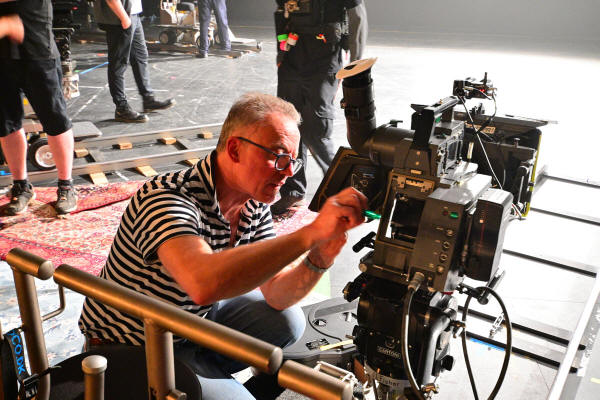 "The
camera is on fire". ARRI Rental's Sascha Mieke walked up to the camera and pulled
the plug. Changed a fuse and saved the day. "The
camera is on fire". ARRI Rental's Sascha Mieke walked up to the camera and pulled
the plug. Changed a fuse and saved the day.THa: Any good anecdotes about the ARRI 765 on set? It's always the things that go wrong that end up being interesting - and something did go wrong: the camera caught on fire! The best anecdote we had from the entire shoot was we had a wonderful guy named Sascha Mieke coming up from Germany to help us make the film. He's an extraordinary man to meet because he's travelled the world working with 65mm film for a lifetime. He used to be focus puller for a very famous German Steadicam operator. They were a team and they did "Gladiator" and "Seven Years in Tibet", a bunch of movies [including 65mm]. We had him on the shoot helping us. Suddenly, when we were getting ready to begin the first shot with the 65mm camera. We were set with 9 minutes of film. So it's very exciting. Everything had to be very, very tightly planned because 9 minutes is not a lot when you want end up with a full 8 minutes of footage that is actually useable. So, just as we were about to say "action", smoke suddenly started coming out of the camera. The camera was on fire! Sasha quickly walked up to the camera and pulled the plug. Anders Lindved, who operated the camera away. Thomas Holm, who is his focus puller on the 65, stepped up and they "attacked" like a Formula One pit crew. Like a car repair team, they just stepped in and starting taking everything apart. Kristoffer and myself, we were thinking "OK, so I guess this is only going to be like a three-format film because the camera is on fire". We were like two men waiting on their wife having a child. Suddenly "doctor" Sasha came up to us, and pulled off his gloves and said "A fuse went, and part of the camera has broken down. That's it. The monitor system doesn't work anymore. But actually, we just need to change this fuse and then the camera itself is going to work." The fuse was something that you could buy in a local car shop nearby. So we had a runner drive to the nearest shop and buy a fuse, put it in the camera and then it worked again [laughing]. Without the monitor I couldn't see what Anders was shooting. He was the only one who could see what he was shooting. It was totally old-school. He worked the entire camera through the eyepiece. Anders had also planned doing some of the movement of the camera using the monitor. That had to go out the window. So he had to do everything with the eyepiece. But he is a very talented guy and solved it extremely well. THa: I remember he came up with this fuse saying, "we need one of these". OK, well, it took 90 minutes and then you were up and running again. Jesper: Exactly, we had a huge delay because of that. When shooting with old-style lamps and stuff, people always get amazed. And when you have so much electricity, and lamps burning in a room, it becomes extremely warm. We actually did this twice. We did it on “CUT”, but a month later we were back in the same studio shooting "Nothing Ventured" on 35mm and that was four days of 40° C inside the studio. So intense. This day was like our warm up. But it was really, really hot, yeah. THa: How did you to decide which scenes, formats and resolution to go with her choreography? Did you think about that beforehand? Jesper: Yes, we actually did shoot our rehearsal on four cell phones on the first prep day. A cell phone test where I had the opportunity to explore the different pieces of choreography when I came home. How would they translate to the different formats and what would I want to use in which parts? It was very important for me that all formats would be rolling at the same time. We knew that there were moments, like, OK, this is a "65" moment, and this is a "16" moment. But we always wanted to cover our bases by having all four cameras rolling. Another reason was to be able to make a version where one could see all four [formats] used simultaneously. That's something that, when we show this film to people physically, we will always show that version as well, so people can see the difference between the formats. There's a moment where you're in a close up on Super 8 and then she snaps her fingers and we cut to 65. There are a lot of moments where you go 8, 16, 35, 65, 35, 16 and 8. There's a lot of rhythms like that, and then suddenly in the end, there's a moment where she dances in 35 and then Kris on his Super 8, he captured almost the exact same framing. It's scene where Selene is the same size on screen, so I just cut right there because then there's a moment of film where you sort of think "OK, it's the same frame, but something about the image has changed". So it's kind of a meta movie, in that it's showing the dance, but it is not only about the dance. The formats are also part of the storytelling, which is not normal. I think now, in this post-modern world, where film is something that you choose to use and not something that you have to use, it's very interesting to see how formats are becoming part of the storytelling. Because these formats used to just be "the medium". If you watch films from the late 80s up until the mid 90s, you can see how the filmmakers were trying to get rid of the grain. They didn't want it. Now when people shoot on film, it's to maintain the grain [smiling]. THa: "The Holdovers" (2023) starts up like a 35mm print with a little bit of shake to make it look like a film from 1979. Jesper: That film is shot digitally, but it's very well made. I was talking to Manuel Claro about that one because I was working up my next project, which I may want to shoot on film. He showed me scenes from "The Holdovers". You actually don't have to shoot film all the time. You just have to maintain the philosophy of shooting on film. And he's right. I'm more connected to that than the aesthetic of film. I love the aesthetic of film per se, but it's very expensive. But I am very keen on always maintaining aesthetic of working as if with using film. You need discipline when working with film. A very strong work ethic on set. When do you rehearse? When do you shoot? When do you prep the next shot? How do you do all these things? It has to be a very systematic process, where as on digital you can be a bit more floaty, because the consequence of having your camera rolling on is not that big. And I really like the way it feels to shoot films when you work on film. So yeah, that ["The Holdovers"] was a very interesting piece to look at, because they make it look really retro. Retro in a very nice way. |
|
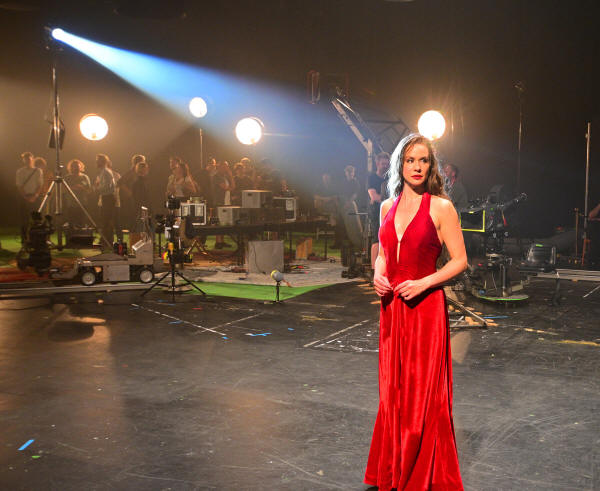 The formats are also part
of the storytelling with extraordinary talented Selene Muñoz in the
center of it all. The formats are also part
of the storytelling with extraordinary talented Selene Muñoz in the
center of it all.THa: The use of the 65mm camera, did it present any problems compared to 8, 16 and 35, or was it just like any other camera for you? Jesper: It's a very big camera, but the wonderful thing about the Arriflex 765 is that it's very well made camera. It does just feel like a normal camera when you don't become overly stressed about the size. It just works so incredibly well. The worst camera to work with is actually the Super 8 camera because there are not that many professional Super 8 cameras. And even on this production, we had problems with some Super 8 film getting chewed up by the camera, so we lost a small amount of footage for that. But the ARRI 765, the ARRIFLEX 416 S (Super 16mm) ARRIFLEX ST (35mm) are basically all like brothers and sisters, They're related so they work in more or less the same way with the same plugs, everything, and they just run. German made quality. It can't be finer than that. THa: Let's talk a little bit about post production of “CUT”. You had these four, actually five films. How did you edit it? Was there any special philosophy? What kind of scenes did you want with the 8, 16, 35 and 65? How did that transfer into post production? Jesper: The first step of the first version was that we sent it all to England. We sent it all to Kodak film lab in Pinewood, who also did a sponsorship. They did all the post processing for free. So you start off by having a strong working relationship with them. They're technicians who are the best in the world. I was very amazed because on the other film, "Nothing Ventured", we used Mutascan in Finland, very good people, but a much smaller company. So normally, when we send to Finland, it takes a week, or sometimes more, before we see anything. With Kodak, I sent it and they replied "We have it" and then three hours later I had dailies! Because that's the professional workflow. You ship the film, and then you get the daily so you can watch what you're shooting and correct errors if there are any. It's just super efficient. We looked at everything and we were kind of amazed because it's all shot on Kodak 200T Vision3 stock on all four cameras. There was actually quite a difference between the look of the various rolls of film. The colours were different. So we called up Kodak and asked "...what's the process here? How do you do it? Is it scientific or ... how human is the process?". Kodak was very honest,
So we
did that instead. We got files of
every format, and then I started putting everything into timelines
in Premiere
Pro, which I use for editing. I basically just tried to do it like a session where all the sound from
all the different takes were all placed beneath the film. Then in four different tracks I linked all the footage up, so it was kind
of like a multicam session. Now I have all the
footage that we shot viewable on one screen, and that's
what you would call a multicam session. If one did a live interview with four cameras, it would look like that as well. |
|
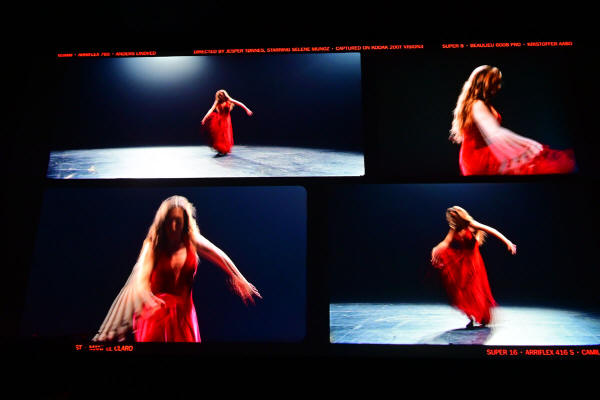 Selene Muñoz
as seen in the "CUT" demo of all four Kodak formats presented side-by-side
and over-under. From top left is 65mm, then Super 8, and below left is 35mm
and Super 16. The formats are also part
of the storytelling. Selene Muñoz
as seen in the "CUT" demo of all four Kodak formats presented side-by-side
and over-under. From top left is 65mm, then Super 8, and below left is 35mm
and Super 16. The formats are also part
of the storytelling.THa: Was it important to you to get this film look of the final result when we saw it digitally the other day? Jesper: From the beginning, I said this film shouldn't have "a look". It should look like the film stock because the film stock has a colour profile and I actually believe that it's very clear to see. When you work in the colour grid process, and do changes, you can actually see that the film reacts better to changes that push it towards its natural look than if you were doing an outdoor shot and you want it to look like you're in the Sahara, where (for example) you make everything orange. On this one I was very, very keen on making everything look as close to the film stock look as aesthetically possible. THa: It looked great, I mean, her red dress and the black background - it was the same on all four formats. And then of course as you go up and the format gets bigger and bigger, it becomes more velvet like, and sharper with more detail. You get more into it. And with the Super 8 millimeter, and the scratches, I'm reminded "it's the movies", it is wonderful! I like that. When you showed the second part, with all four formats, you even included a hint of perforations in some scenes. Jesper: Yeah, yeah. We scan everything with the perforations. When you scan stuff like that, it's 6.5 K material, so that's 6500 pixels. THa: From which of the stocks? Jesper: All of them, 16, 35 and I also think that's the same for 65. All the machines can have an output of 6.5 K and the version we showed in the cinema, that's a 2K file. THa: I assume what we're seeing is the original film grain, with nothing artificially added? Jesper: No, no, no. We've never done anything like that [electronic grain - ed.]. We don't add any artifacts whatsoever. We don't remove artifacts either, but we certainly don't add any. At one point, when the light goes out and there's a spotlight, in that section of the film, the perforations are in the film as well. I've removed them from most parts because they're very distracting to an audience who are not used to seeing perforations. On that version - because everything was dark - it's kind of weird shapes in the sides of the image. That's for the connoisseurs who know what they are looking at. When you work with a professional post production house, as we did here for the grading and export, you have a lot of discussions because people have been getting so accustomed to working on behalf of producers who want to save money on everything. So when you say to them "I want an export that is at least 4K", they're asking: "What would you ever use that for?" "I don't know. I don't know what you would use it for, but this film is going to live on for as long as it can, so let's make it like a format that can last 20 years". Because when you look how digital started, so much of the stuff we shot in the early 2000s are a lower grade, at only 720 pixels. It's inadequate, that's why. |
|
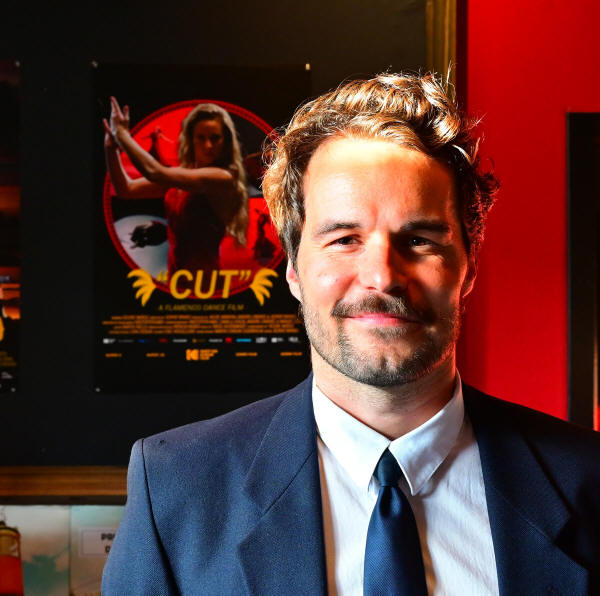 "I
hope more people will do stuff like we've done here. Try it just for a small
thing, because it is an exhilarating thing to do, to shoot and work with
these cameras." Jesper Tønnes "I
hope more people will do stuff like we've done here. Try it just for a small
thing, because it is an exhilarating thing to do, to shoot and work with
these cameras." Jesper TønnesTHa: Are you happy with the result of “CUT” , the way we saw it in the Empire the other day? Jesper: Very much. I had the pleasure of going into the cinema early in the morning and watching “CUT” alone for the first time. I was sitting there and I had this feeling, "This is crazy! I have seen it on bigger monitors, but I made this film and had all these ideas of how it was going to work when you show it in a cinema. Then you spend half a year looking at it on small screens and suddenly now we're back in the theatre and I'm being reminded why we did it". Because it worked. I think it worked so well in the theatre, where we are changing between formats and the image becomes wider and narrower, because the Super 8 is 4 by 3 and the 65 is 2 to 1 aspect ratio, so there's a huge difference when you jump between these formats. I am a very happy guy. THa: Have you received any interest from the outside world? Jesper: Well, we just received a very wonderful message yesterday telling us that we've been selected for the San Francisco dance film festival. So the dance festival circuit has already started, because we applied for some festivals and they said "Yes". So things are starting to move and we'll be showing it in San Francisco this October. I hope there's going to be more of that. We talked to Kodak about it and we talked to ARRI about it, and of course they're very happy that it exists. I would love to get the film out there and, as you can hear, I really enjoy talking about all the very nerdy aspects of working on film. I think the film is going to do its own thing. Maybe it will get a lot of attention. Maybe it won't. My job was to make it happen, and now it's free. Now it's going to go travel out into the world. So what happens from here is up to the audience. THa: Will there be 70mm prints available for festivals and screenings? Jesper: No, I don't think there will. We would love to do that, but I would have to pay that out of my own pocket and I don't have that kind of money. If I could I would love to do a 35mm print. But that would still be the digital file printed. We're sitting here in my living room and I have the raw footage behind me on a shelf. Cutting that up and doing a full analogue process, or getting prints of that and doing an analogue master would be an insane process. It would be an awesome, but also insane process. Christopher Nolan does it that way, including old school colour timing. He does the full analogue process. The rest of us, we have to settle [laughing]. THa: What are your future plans - any more 65? Jesper: I would love to shoot more 65. Actually I will say that we shot on 200 T, and if I had known how fine grain that was, I think maybe I would have gone with 500 T, because the 200 grain is too fine. Because when you cut to it, the analogue aspect of the image almost of becomes irrelevant. It doesn't look that analogue. When you cut from 35 to ... because we also do that in "Nothing Ventured" ... the actual reaction that we've been getting from most of film people who see it, professional people who work with film every day, is “Oh, you're cutting to digital?”. And then we do some close-ups and they're like "No, OK wow!, OK this is film?" because then they can see it in the close ups. So, thinking about how expensive it is to shoot on film, I would actually say that it's a tribute to ARRI and their large format cameras like their Alexa and their 65mm digital cameras. I'm also quite interested in shooting on those. Because what I love about 65 is how the optics work. If I had the money, I would do it, but that is a very extreme dream situation where I might ever have the money to shoot longer stuff on 65mm [film]. I hope more people will do projects like we've done here. Try it just for a small thing, because it is an exhilarating thing to do, to shoot and work with these cameras. Its one thing to see these cameras in a film museum. But doing it with the equipment, and it's like smelling the smoke, you know [laughing] - that is something that is the greatest gift you can give yourself, to "get your hands dirty" with the medium. I'm so happy I did it, and I hope that because I did it, it will not be the last time. THa: That's great. Thank you for your time. Jesper: My pleasure. |
|
The Format is part of the Story
|
|
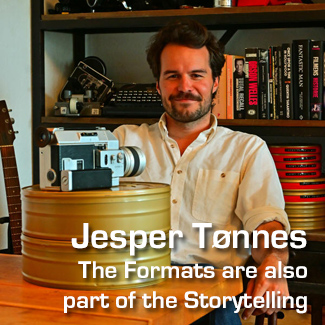 • Go to Jesper Tønnes: The Formats are also part of the Storytelling |
|
| Go: back - top -
news -
back
issues Updated 22-01-25 |
